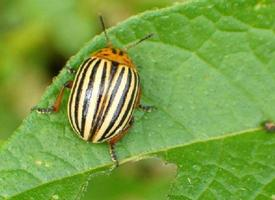
Poids et mesures
| Longueur | 12 mm |
|---|
Statut de conservation
| Intrépide |
Description de l'animal
The Colorado potato beetle, scientifically known as Leptinotarsa decemlineata, is a notable insect primarily recognized for its significant impact on potato crops. This beetle is native to Mexico and the western United States but has expanded its range across North America and into parts of Europe and Asia, largely due to the global trade in potato crops. Its adaptability and resistance to many pesticides make it a formidable pest in agriculture.Adult Colorado potato beetles have a distinctive appearance that makes them relatively easy to identify. They measure approximately 9.5 to 11.5 mm in length and are oval in shape. The beetles have a yellow to orange exoskeleton with ten characteristic black stripes running longitudinally down their elytra (hardened forewings). Their head is small with a pair of compound eyes, and they possess strong, chewing mouthparts suited to their diet of potato leaves. The thorax and legs are black, and the beetles are capable of flight, although they often prefer to walk or run.
The life cycle of the Colorado potato beetle includes four stages: egg, larva, pupa, and adult. Females lay clusters of bright orange eggs on the undersides of host plant leaves, primarily potatoes, but they can also affect other members of the Solanaceae family, such as tomatoes, eggplants, and peppers. These eggs hatch into larvae, which are red or orange with black spots and have a soft, plump body. The larvae are voracious eaters, causing significant damage to crops by consuming the leaves, stems, and sometimes the fruit of the plants. After several larval stages, the larvae burrow into the soil to pupate. The adult beetle emerges from the pupa after a few weeks, ready to feed and reproduce, completing their lifecycle.
The Colorado potato beetle's diet is almost exclusively solanaceous plants, with a strong preference for potatoes. This diet has made them a significant agricultural pest, as they can decimate potato crops quickly if left uncontrolled. Their ability to rapidly develop resistance to chemical pesticides has made management increasingly challenging for farmers. Cultural practices such as crop rotation, the use of barrier methods, and the introduction of natural predators or biological control agents are among the strategies employed to manage beetle populations.
In terms of ecological impact, the Colorado potato beetle serves as a reminder of the delicate balance within agricultural ecosystems and the consequences of human intervention, such as the introduction of non-native species and reliance on chemical pest control methods. Its ability to adapt and thrive in varied environments, coupled with its dietary preferences, continues to challenge scientists and farmers alike in managing its population without causing undue harm to the environment or human health.
Nouvelles photos d'animaux
Top 10 des animaux
- Dolphin gull (Leucophaeus scoresbii)
- Japanese macaque (Macaca fuscata)
- Stone loach (Barbatula barbatula)
- Greek tortoise (Testudo graeca)
- Russian tortoise (Testudo horsfieldii)
- Galápagos tortoise (Geochelone nigra complex)
- Diana monkey (Cercopithecus diana)
- Moustached guenon (Cercopithecus cephus)
- Common flying dragon (Draco volans)
- Galápagos penguin (Spheniscus mendiculus)